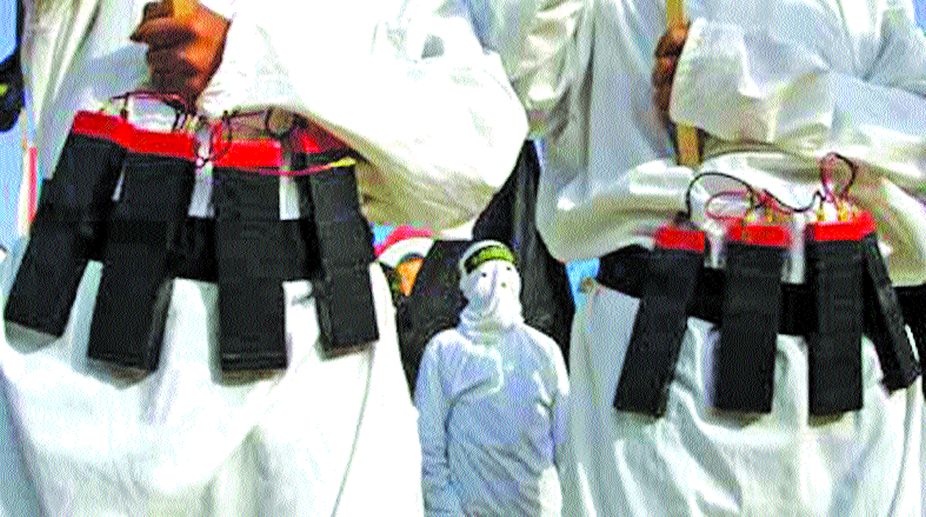Terrorism, in one form or another, has existed for centuries. While its goals change according to the prevailing context, the basic technique ie using force to achieve political, social and religious ends has been the same throughout history, and has often included the use of suicide attackers.
Modern suicide terrorism began in the 1980s under conditions where the coercer was the weaker actor and the target the stronger. From Hezbollah, Hamas, the Tamil Tigers and Chechnyan rebel groups to Al Qaeda and the militant Islamic State group, the rhetoric of major suicide terrorist groups reflects the logic of coercive punishment. This technique’s purpose is to inflict punishment and provoke fear. Triggered in part by suicide attacks elsewhere, a trend of such attacks took off in Pakistan in 2004, with waves of increased frequency.
The protracted terrorism campaign in Pakistan seems to base itself on three levels of validation: strategic, social and individual — the strategy being to induce changes in the status quo through political coercion. If terrorist groups did not believe that suicide attacks would advance their political goals, they would not carry them out. The reason behind the uptick in such attacks is that its sponsors know that the strategy pays off and is effective in achieving some political and societal changes. People belonging to minority Islamic sects and minority religions, security forces, lawyers, etc are tactically selected to maximise the damage in terms of casualties and intimidation.
Social validation comes from terrorist groups’ ability to exist, nurture and thrive in society. Our government and society seem to tolerate their existence and recruitment efforts, and legitimise their proclamations of hate and religious
purity.
The endless supply of individuals willing to give up their lives to attack innocent people provides the third validation. Religious indoctrination, weak states, hegemonic structures, inequality, poverty, and a lack of democracy and rule of law enable this supply of ‘willing executioners’.
Suicide attacks do not appear out of thin air, they require systematic efforts. Stopping this heinous act requires a multi-pronged strategy involving intelligence, security and operational measures, response and deterrence mechanisms, awareness campaigns and community involvement, and influencing the attitudes of such groups’ constituencies.
Intelligence is key, and both the federal and provincial law-enforcement agencies need to enhance their capabilities. Data collection and analysis, with support from modern technologies, is vital for eliminating terrorism’s infrastructure. Increased coordination among intelligence and law enforcement to collect, share and analyse data on terrorist threats is needed.
Even with such measures, attacks may occur, which is why the government must have effective response measures. Disaster preparedness plans and structures must be developed, and technical, mitigation and relief teams formed, to deal with rescue and evacuation. This would reduce public apprehension and panicked demands for extreme measures that may imperil democracy. Involving the community in emergency disaster preparedness would be of benefit.
Terrorism is a group endeavour and, thus, deterrence efforts should be mainly directed at groups rather than individuals. A credible threat of severe punishment that implies a group’s demise would presumably act as a deterrent, while addressing the grievances of larger population groups, to which the terrorists belong, may be effective in changing sympathies. A consistent, well-publicised de-radicalisation and reintegration plan for deserters and sympathisers would also be invaluable.
It is imperative to gain insights into the conditions and processes leading up to terrorist atrocities to identify possible interventions to prevent/ break the cycle of retaliation. Physical security measures may prevent attacks from occurring, but they do not eliminate the ideology or the enthusiasm for it.
When we tolerate religious parties and schools censuring religious minorities, women, and progressive sections of society, and subscribe to the absence of separation between religion and state, terrorism is inevitable. Collective efforts are needed at all levels of government and society to create an environment that discourages militancy and fanaticism.
An outright rejection of sectarian religious education, and advocating for policies and laws that create a more unprejudiced and equal society, can serve as an antidote to terrorism. The syllabi taught in madressahs must be regulated. Civil society, progressive writers, academics, activists, and print and electronic media must be given support and protection to counter prevailing narratives that inspire extremism through education and awareness campaigns that promote tolerance.
Dawn/ANN.












